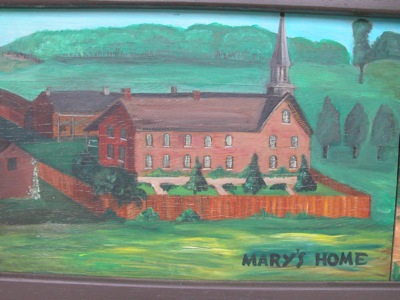Friday, July 20th, 2007
Indiana convent: a story of survival
Missionary effort springs from Maria Stein base convent
By Shelley Grieshop

Photo by Shelley Grieshop/The Daily Standard
Pictured is a painting of the former Mary's Home convent in Trinity, Ind. The convent was located about a mile across the Ohio border, just east of Holy Trinity Catholic Church along state Route 67.
The trials and tribulations endured by the early sisters, priests and brothers of the Precious Blood were many as they worked to establish their ministry in the local German Catholic communities in the 1800s.
It took perseverance and a lot of faith - qualities the Rev. Willibald Willi was known for during his term as the resident priest at Mary's Home convent in Trinity, Ind., built in 1854. Willi was based at the Maria Stein convent and suffering from an advanced case of tuberculosis when he offered to take on the assignment at the proposed Indiana convent.
"Tuberculosis was everywhere at the time," said Sister Regina Albers, a historian at the Maria Stein Center.
Willi headed out with four Precious Blood sisters and two religious brothers in horse-drawn wagons to start a new Catholic mission - the first one to be built outside the Ohio border.
Mary's Home convent, formerly located about 1 mile east of the current parish of Holy Trinity along Indiana Route 67, was one of six convents built between 1846 and 1856 in an area radiating 22 miles from Maria Stein. Minster native, the Rev. David Hoying, is current pastor of the Trinity parish.
The convent was located 15 miles northwest of the Himmelgarten convent in St. Henry, which was built two years earlier.
In 1852, the Precious Blood community bought 240 acres of land in Jay County. Because there were no priests initially to begin the assignment, the ministry was deferred.
Two years later a group of brothers finally began work to transform a log house on the site into a chapel. A small residence was soon annexed for the sisters to live and a tiny "hut" was constructed nearby for the priest, according to information compiled from the Sisters of the Precious Blood publication, "Not with Silver or Gold."
By mid-August, wagons full of furniture, chapel supplies and food were delivered and the convent became the center of religious ministry for the surrounding countryside. But problems soon arose as small yields from the garden planted earlier that year dwindled quickly during the cold winter .
As the situation became dire, Willi literally went begging to the Ohio convents and returned with a replenishment of much-needed food. However, the trip took its toll on his already failing health and several months later he died.
During the last sermon to his congregation, Willi pleaded with them to "love God and their neighbor" and "come to the aid of the poor souls in purgatory."
Under the direction of the Rev. John Wittmer, a much bigger convent and chapel were built in 1855.
The sisters worked alongside the priests and religious brothers performing farming and gardening duties, but were admired for their amazing skill in weaving and spinning, sewing and needlework. Like their counterparts serving in Ohio, they also were educators to area children and in charge of the care of the priests and brothers.
By the early 1900s, many of the convents began to close and sisters were reassigned. In 1916, the Mary's Home convent property was sold and the sisters left.
Today, none of the original buildings remain and the property is used privately as farmland.
Editor's note:
This is the sixth article in a Daily Standard history series on area Catholic convents that once housed the Sisters of the Precious Blood. Information for these stories mainly was provided by Sister Regina Albers, a historian and current relic and museum curator at the Maria Stein Center.

Photo by Shelley Grieshop/The Daily Standard
Sister Regina Albers, curator of the Maria Stein Center Museum and Relic Shrine, holds up a handmade rug that was created by Sisters of the Precious Blood who lived at the former Mary's Home convent in Trinity, Ind. The rug was donated to the Maria Stein Museum in 2002 by Ruth Wayne Schieltz of the Versailles area and previously hung in her grandparents' (Gerhart and Elizabeth Rosina Diller May) home near the convent. Elizabeth May purchased it from the nuns who sold such items to make a living.

